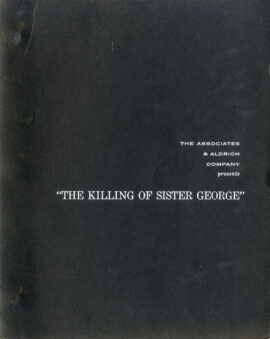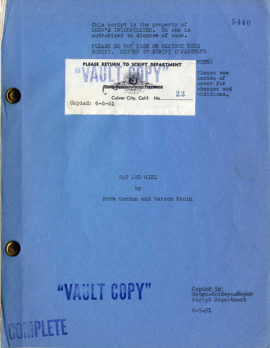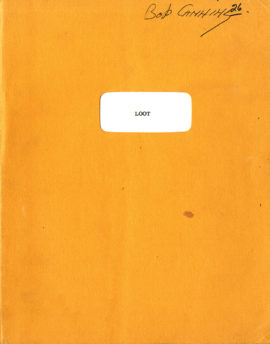



Mario Puzo (source, screenwriter), Francis Ford Coppola (screenwriter, director) THE GODFATHER (Mar 1, 1971) Second draft film script
New York: Paramount Pictures, 1971. Vintage original film screenplay, 11 x 8 1/2″ (28 x 22 cm.), 175 leaves, printed on rectos only. Black titled Studio Duplicating Service wrappers. Title page present, dated March 1, 1971, noted as SECOND DRAFT. Near fine in very good wrappers, brad bound, mimeograph.
“I believe in America.” Those are the first four words spoken in Francis Ford Coppola’s screenplay and film of The Godfather, based on the best-selling novel by Mario Puzo. The initial draft of the screenplay was written by Mario Puzo alone; this second draft screenplay, dated March 1, 1971, is essentially director Coppola’s rewrite of Puzo’s first draft.
Coppola’s original conception was to begin the film with the wedding of Don Corleone’s daughter Connie, a sequence that would introduce all of the story’s major characters. When Coppola shared this concept with a friend, the friend responded that it was fine, but comparatively conventional. Coppola had just won the Academy Award for writing Patton, a screenplay noted for its striking opening sequence. Why not try something similar for The Godfather? So Coppola came up with the sequence, taking place on Connie’s wedding day, of the undertaker humbly asking godfather Vito Corleone for a favor, namely, justice against the young men who had raped the undertaker’s daughter. It turned out to be one of the greatest openings in the history of American cinema.
Coppola’s stroke of genius in adapting Puzo’s novel was not to treat it as a traditional gangster story, but as an epic family saga in the manner of Luchino Visconti’s Rocco and His Brothers (1960) and The Leopard (1963). Marlon Brando as godfather Vito Corleone has more than a little in common with Burt Lancaster’s noble patriarch in The Leopard. Coppola even used the same composer, Nino Rota, that Visconti had used in his two epics. The studio initially wanted to update the story to the present and shoot it in Kansas City! Thankfully, Coppola insisted on retaining the novel’s post-World War II setting and shooting it in New York.
Coppola’s second draft screenplay is very close to what was actually filmed, with some sequences omitted, and others rearranged. Unlike the completed film, the screenplay was non-linear, including flashbacks and flash forwards. For example, in the screenplay we learn of the death of Luca Brasi, the shooting of Don Vito, and the death of Sonny Corleone before we see those violent acts committed. In the movie, on the other hand, everything proceeds chronologically. The film omits the screenplay’s flashback sequence to 1920 showing young Vito Corleone in New York’s Little Italy, a sequence that would later appear, considerably expanded, in Coppola’s Godfather II. Among the other omitted sequences — a sequence early in the story showing Don Corleone at the deathbed of his older consigliere Don Genco; a sequence showing Michael Corleone (Al Pacino) in bed with his fiancée Kay (Diane Keaton); a scene with Kay and Michael’s mother in church. People remember The Godfather as an unusually violent movie, but the film’s violence is, in fact, sparingly and effectively used. The first significant instance of on-screen violence, the decapitated horse’s head left in the bed of an uncooperative Hollywood producer, doesn’t occur until page 31 of the screenplay (more than a half hour into the film).
Some dialogue was cut. There was also room for improvisation. The cat that Marlon Brando plays with in the opening sequence was a last minute idea, added on the day of the shooting. An even more significant improvisation was added by Brando to Don Corleone’s death scene. In the screenplay, Don Corleone is simply playing with his grandson in his tomato garden when he suddenly drops dead. During the shooting Brando, unsatisfied with the little boy’s reaction, came up with the idea of putting an orange peel in his mouth and pretending to be a monster, a brilliant touch which succeeded in provoking an authentic reaction from the little boy portraying his grandson. The last part of the famous line “Leave the gun. Take the cannoli,” was an improvisation by actor Richard Castellano.
It was screenwriter Coppola’s idea to intercut the bloodbath from the novel’s conclusion — where new godfather Michael Corleone wipes out all of his enemies — with the ritual baptism of Michael’s godson. One of the most impressive things about Coppola’s screenplay is its symmetrical structure. The baptism of the godson at the story’s end echoes the wedding of Vito’s daughter at the beginning. The sequence of wedding visitors paying homage to Vito at the story’s beginning is echoed by a similarly staged sequence of characters kissing the hand and otherwise paying homage to godfather Michael at the story’s conclusion.
The Godfather was a box office smash in its time and remains one of the best-loved films in Hollywood history. The American Film Institute ranked it second, just below Citizen Kane, in its list of the greatest American films, and director Stanley Kubrick went even further, calling it the greatest movie ever made. It won Academy Awards for Best Picture, Best Direction (Coppola), Best Actor (Brando), and Best Adapted Screenplay (Puzo and Coppola), proving the conventional wisdom that it takes a great screenplay to make a classic film.
Out of stock



![LES CREATURES [THE CREATURES] (1966) French film script](https://www.walterfilm.com/wp-content/uploads/2021/04/LesCreaturesSCR_a-270x345.jpg)
